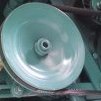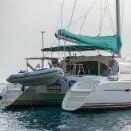Leaderboard
Popular Content
Showing content with the highest reputation on 04/04/17 in all areas
-
This post cannot be displayed because it is in a forum which requires at least 10 posts to view.
-
This post cannot be displayed because it is in a forum which requires at least 10 posts to view.
-
Consultation on red diesel: https://www.gov.uk/government/consultations/red-diesel-call-for-evidence/red-diesel-call-for-evidence It's about all aspects of red diesel use, so boaters need to get in there and make sure we're not forgotten.1 point
-
Aren't the fans on Listers flywheel end ? I assumed from the op he meant a fan on the front of the engine like you used to get on old cars !1 point
-
Best keep quiet. Then the government might quite correctly conclude there is hardly any diesel used by boats and decide to not to bother with the expense of collecting the duty.1 point
-
I have deliberately chosen not to contribute because I think there has enough been said already without my own two pennarth. I know that this is a discussion forum, but too frequently, in my view, a perfectly straightforward question which might be interesting to many members, turns into what I described as a "pissing competition" This is the reason ( I suspect) why many people read the postings on this forum but refrain from joining in, as I frequently do. Howard1 point
-
Hi Andy, I think they are both Joseph Ash, the press brake formed handle was typical of their work.1 point
-
As said, a NRV might work but it depends on how good it is and how much crud you have in the tank because a tiny bit getting stuck in the NRV could prevent it from completely closing. An accumulator might prove a better way forward.1 point
-
This post cannot be displayed because it is in a forum which requires at least 10 posts to view.
-
This post cannot be displayed because it is in a forum which requires at least 10 posts to view.
-
This post cannot be displayed because it is in a forum which requires at least 10 posts to view.
-
The engine temperature is controlled by the thermostat, so if the coolant were 'more efficient' at carrying away the heat the thermostat would not open as much to keep the correct temp. If you have an engine temp of 65c and a thermostat of 75c then there should be little if any hot water passing to the skin tank as the coolant is not hot enough to open the thermostat. So at a guess it is either all ok and the gauge has gone wrong, or the thermostat is opening too soon, or never closing fully.1 point
-
Assuming the op meant he had set the pump pressure to 4bar (not 4 psi) then that is equivalent to about 130 feet of water, so I agree that a few inches more or less in the tank will be very hard to measure any change in the backflow.1 point
-
BUT it says it connects to a car battery .. so unless you park your car on the deck you're going to need a long cable1 point
-
Back flow through the pump delivery valves. Once you shut the inlet valve from the tank there is nowhere for the backflow to go so it doesn't happen. Theoretically!, if you fill the water tank the rate of cycling will reduce because the greater inlet head will slow the backflow. I expect any difference will be hard to measure accurately though. N1 point
-
This post cannot be displayed because it is in a forum which requires at least 10 posts to view.
-
But then, on another occasion, a boat crewed by two guys moored so close in a tight situation, their stern lines crossing my bowlines, my bow button touching their stern button, i sat watching tv with the doors open and said two guys sat on the stern for at least an hour, just feet away, chatting loudly, laughing, on the mobiles, until finally i did lose my rag and pretty sternly asked if theyd give me a bit of peace and move to their bow for the rest of the party. They werent too happy but complied. A bit later they pulled up stumps and moved away from the miserable old codger behind. Ah! Sometimes you just have to stand up.1 point
-
This post cannot be displayed because it is in a forum which requires at least 10 posts to view.
-
Doesnt it depend on the efficiency of the silencer and also wind direction and other ambient conditions? Sometime low frequency diesel can produce a hefty thumping resonance maybe against the armco and echoing in a tree shrouded cutting, and dependant on engine revs set. I consider my beta42 and exhaust system vrry efficient and like said, fishermen dont here me coming, but i,ve walked a distance from the boat moored, charging batteries, and can detect that resonance but only on still air evening occasions. If the complainant was nice enough i,d explain my situation and if i couldnt comply i,d probably feel inclined to move on a bit further. I dont need the agro of someone banging on the boat or doing worse mischief cos i pissed him off. Live and let live.1 point
-
Mostly because technology doesn't work. GPS is patchy anyway - and you'd have to weld it to the boat to stop someone unhitching it, riding a bike twenty miles and coming back to the same spot. Dishonest people don't suddenly get forced into compliance by technology - they just find a way round it. Meanwhile you add costs and penalise all the honest folk out there - the Boat Safety scheme is an obvious example of expensive pointlessness.1 point
-
1 point
-
I figured you would be the first Laurence ...actually wooden boats respond very well to being live don where they can be aired and kept warm and fussed over - it is the lack of those things which causes them issues..1 point
-
A prime example of why we should have gone completely metric back in 1971. A missed opportunity (no, its nothing to do with the EU or Brexit).1 point
-
This post cannot be displayed because it is in a forum which requires at least 10 posts to view.
-
This post cannot be displayed because it is in a forum which requires at least 10 posts to view.
-
The canal water temperature needs to be above the dew point of the air or you will get condensation. Once it is, a blower (I used an old bilge blower and a bit of ducting) to mix the air inside the tank and blow in fresh air should dry the steel. Mine took a couple of hours. The ducting helps to get fresh air unto the dead spaces. I think that being cool in there the cold damp 'heavy' air has no reason to rise up out of the tank, so blowing fresh air in mixes and warms the cold damp air and pushes it out the top.1 point
-
I find Nicholson's are very good for cruising, but they start going out of date as soon as they are published. Particularly the nice pub in the guide has either changed, or more likely closed when you get there. If you are used to using Ordnance Survey 1:25000 maps, then you quickly get a feel for the landscape as you boat through it as Nicholson's use these maps. If it is a new place to me, I'll often download a CaRT Boaters Guide for the each canal or river just before the trip. This gives additional information, stoppages etc and is generated from CaRT's own database, so should have all the information that CaRT are actually aware of at the time it is downloaded. In particular, lock opening times, notice periods and contact 'phone numbers may well have changed since the Nicholson's was published. The Thames is on Environment Agency waters and won't be covered. Hopefully you are aware of licence requirements for the Thames section of your trip. From Teddington to Brentford it is tidal and covered by the Port of London. They have plenty of good advice for recreational boaters on their stretch. Officially you need VHF radio and someone licensed to use it on board for this stretch I believe. CanalPlan AC is also good for working out sensible travel times based on how much cruising you want to do each day. That's just me. I tend to plan trips a bit in advance and find out anything unusual about the route, but am not fussed about altering things as I go. Some plan everything in obsessive detail and stress out about meeting the plan. Others up mooring pins and set off in to the blue. The obsessive planners have less fun. The no planners have exciting adventures that often are only fun in retrospect! For rivers, if you've not been boating on them before, make sure you have an anchor, chain and line. If you have an engine failure this will stop things getting worse. Take notice of strong stream warnings and closures. Treat the rivers with respect. I wear a life jacket on big rivers. If mooring up in the flow, try to get the bow facing upstream. This makes mooring easier and protects the rudder and prop from debris coming down. Adjust the mooring lines as the level changes. For tidal stretches I always go by the advice from the lock keepers. They know their stuff. I can't give any specific advice for Bradford on Avon to Brentford, as I've not cruised that far south yet. Enjoy your trip. Jenny1 point
-
1 point
-
1 point
-
Absolutely. It's obvious. Narrow canals, narrow boats, narrow minds... A great strap line for the Midlands. JP1 point
-
after precious little movement in Jan and Feb, Kathy and I finally escaped from Loughborough last week for a good run up to the leicester summit and down the other side.1 point
-
This post cannot be displayed because it is in a forum which requires at least 10 posts to view.
-
This post cannot be displayed because it is in a forum which requires at least 10 posts to view.
-
Unless you are far more specific about what type of battery you call "acid" we can not give a valid answer. My guess is that you mean a wet open cell battery but even then it is not much help. These run from car type starting batteries through leisure types and semi-traction to AGMs, gels, spiral wound to full traction. All contain acid in one form or another. Ten there are lead calcium or lead antinomy designs. I guess you mean fairly cheap lean calcium leisure batteries. If not come back and be more specific. Point 1 is that however much you pay you will destroy an expensive battery virtually as fast as a cheap battery if you do not take proper care of it, especially ensuring it is kept as fully charged as possible and never deeply discharging it. If you have no means of battery monitoring and no means of non-engine charging you may as well buy cheap. Point 2 is that wet open cell batteries are easy for an ordinary boater to diagnose/test when compared with sealed types like AGMs. Point 3. If you have an Amp Hour counting battery monitor and you do not fully understand how it works, how to set and reset it, and its shortcomings it will be your battery supplier's best friend in encouraging you to ruin batteries. Point 4 If you have a charger capable you can equalise (charge for a short time at a higher than normal voltage) open cell batteries. This may produce a longer useful life. Normally you can not do this on any from of sealed batteries. Now to answer your question. I want an easy way to test and diagnose my batteries so despite some advantages for AGMs I use wet open cell batteries from a well known brand. Others will differ in their views and so would I if my batteries were not easy to get at for maintenance. If being sealed is important to you then AGMs or sealed versions of open cell batteries may be more appropriate. Please take on board my comments about the ease of ruining expensive batteries as fast as cheap ones. It may make better sense to put the money saved by buying wet open cell batteries towards solar charging.1 point
-
Nice to see that Oxford and Cambridge both got through to the final again! Tim1 point
-
Sometimes the contacts stick because of sparking causing a pit in toe contact and a pimple on the other that lock together. Inspect yours and if there is "pimple" try removing it with a small oil stone or contact file.1 point
-
This sounds like our SaniMarin loo with a similar button pad. We almost always use the lowest flush setting ... or the press-and-hold button for a couple of seconds if it needs it. There's probably some info on the web that states how much water is flushed for each button. e.g. 0.5 litre for the 'eco'; 1.0 litre for the other. Obviously the less water you use the longer you can go before emptying the tank. We get 4-weeks for two of us full-time liveaboard. Five if we really need to (by flushing it less) because of a freeze-up or red boards. After a couple of pump-outs you'll soon know how long you can go between them ... and it then pretty much becomes an instinctive habit knowing when the task needs doing. BTW we find pouring a couple of capfuls of 'Odorlos' into the tank after each pump-out helps keep any outside airvent 'whiffs' to a minimum in warm weather. There are really no bad smells produced when actually pumping out the tank.1 point
-
This post cannot be displayed because it is in a forum which requires at least 10 posts to view.
-
1 point
-
That might actually be easier. Laptop adapters come in 19v and they're regulated. There are some with multi-voltage outputs with various plugs but if you can identify the plug size you could get one to suit and eliminate the risk of setting the wrong voltage.1 point
-
1 point
-
If it's necessary to run your engine or genny (and I have no problem with either) why moor close to someone's home ? I avoid mooring by houses wherever possible as a matter of courtesy. Cruise as necessary. If you need to moor for shops or services, turn your engine off, and if you've not run the engine for long enough, then move on until you have, or you're away from peoples home's. The problem is entirely avoidable with a little consideration. Just my view, others are available. Rog1 point
-
Though I am in no way biased I feel I have to say that at least occasionaly whilton get genuine good boats in on a genuine brokerage sale. My bro in law asked me to check a boat out there, his first about 12 years ago and it was awesome so he bought it, kept it five years and sold it on with ease it was that good. He did get in touch with its previous owner and found out lots re its engine ( a clunk clunk ) so it aint always bad. Just sayin like..............1 point
-
Generally, you sit down, and then...... I think Junior has the instructions.☺1 point
This leaderboard is set to London/GMT+01:00


.thumb.jpg.3eb49eb749ffe4774f1e5efa3d74f7a1.jpg)





















